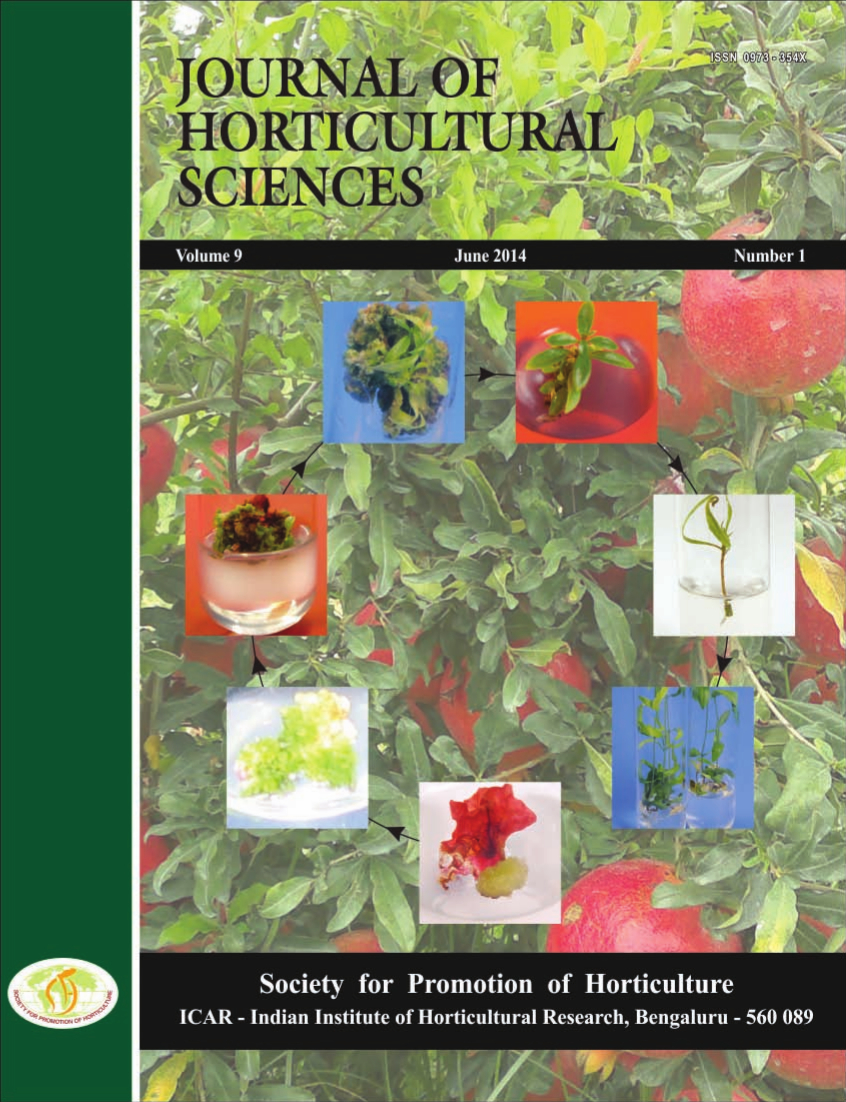Effect of Spacing and Pruning on Growth, Yield and Quality of Cv. Deanna Fig (Ficus carica L.)
DOI:
https://doi.org/10.24154/jhs.v9i1.215Keywords:
Ficus carica, Fig Deanna, Growth, Pruning, Fruit Quality, Spacing, YieldAbstract
The effects of tree spacing (5x2m, 5x2.5m, 5x3m, 5x3.5m and 5x4m) and pruning (8 buds/cane, 6 buds/cane and 4 buds/cane) on vegetative growth, physiological parameters, fruit yield and quality were studied in fig (Ficus carica L.) cv. Deanna in the 3rd and 4th year of its growth during the period 2010-12. It was observed that with increase in tree spacing, growth parameters like leaf number, shoot length, internode length, tree-spread, tree height and tree circumference, along with fruit yield both in terms of fruit number and fruit weight per tree, declined gradually under different pruning levels. Increase in pruning level from 8 buds/cane to 4 buds/cane resulted in increased leaf number, shoot length and internode length. Yield characters, viz., fruit number/tree, fruit weight/tree, fruit number/hectare and fruit weight/hectare were marginally influenced by pruning. However, interaction effects of pruning and spacing were found to be non-significant. Consistently declining trends in photosynthesis rate and stomatal conductance, along with increase in leaf water potential value were observed with increase in spacing. Effects of spacing were more conspicuous than those of pruning. Best results for maintenance of vigour and fruit yield were observed under a spacing of 5x2m or 5x2.5m, and 4 buds/cane pruning. Although there was reduction in average fruit size under closer spacing when compared to wide spacing, fruit quality attributes like TSS and acidity were not affected by various treatments. Effects of closer spacing on growth and yield parameters were more pronounced in the 3rd year as compared to the 4th year, showing better response to treatments in young trees. Fruit yield calculated on per hectare basis showed highest fruit number of 116500-133750 and 274500-299500, and fruit weight of 54.5-62.0 and 158.77- 173.30 quintals/ha, respectively, during the 3rdand 4th year of planting under closer spacing of 5x2m and 4 buds/cane pruning.Downloads
References
Albert, T., Karp, K., Starast, M. and Paal, T. 2010. The effect of mulching and pruning on the vegetative growth and yield of the half-high blueberry. Agron. Res., 8:759–769
AOAC. 1990. Official Methods of Analysis. Association of Official Analytical Chemists, Washington D.C., USA Claude, B., Françoise, L., Michel, G. and Robert, H. 2005 Pruning intensity and fruit load influence vegetative and fruit growth in an early-maturing peach tree (cv. Alexandra). Fruits, 60:133-142
Das, B. and Jana, B.R. 2012. Effect of canopy management on growth and yield of mango cv. Amrapali planted at close spacing. J. Food Agri. Environ., 10:328-331
Davenport, T.L. 2006. Pruning strategies to maximize tropical mango production from the time of planting to restoration of old orchards. HortSci., 41:544-548
Fergusion, L., Michailides, T.J. and Shorey, H.H. 1990. The California fig Industry. Hortl Rev., 12:409-490
Johnson, P.R. and Robinson, D.M. 2000. The tatura trellis system for high density mangoes. Acta Hort., 509:359-364
Mano, T. and Hamada, K. 2005. Effects of close planting on growth, fruit quality and yield in young fig tree. Kinki-Chugoku-Shikoku Agri. Res., 6:72–75
Mano, T., Mizuta, Y. and Moriguchi, T. 2011. Super-high density planting of fig (Ficus carica L.) for early recovery from sick soil and low temperature injury. Hort. Res., 10:367-373
Marini, R.P. 2009. Physiology of pruning in fruit trees. Virginia Cooperative Extension, Publication no. 422- 025, pp 1-8, http:// pubs.ext.vt.edu/422/422-025/422-025_pdf.pdf
Naor, A. and Gal, Y. 2002. Shoot and cluster thinning influence vegetative growth, fruit yield, and wine quality of ‘Sauvignon blanc’ grapevines. J. Amer. Soc.Hortl. Sci., 127:628–634
Nath, V., Kumar, D. and Pandey, V. 2008. Fig. In: Fruits for the future, Vol. 1, Satish Serial Publishing House, Azadpur, Delhi, pp 512
Palmer, J.W., Avery, D.J. and Wertheim, S.J. 1992. Effect of apple tree spacing and summer pruning on leaf area distribution and light interception. Sci. Hort., 52:303–312
Policarpo, M., Talluto, G. and Bianco, R.L. 2006. Vegetative and productive responses of ‘Conference’ and ‘Williams’ pear trees planted at different in-row spacings. Sci. Hort., 109:322-331
Roper, T.R., Patten, K.D., DeMoran Ville, C.J., Davenport, J.R., Strik, B.C. and Poole, A.P. 1993. Fruiting of cranberry uprights reduces fruiting the following year. Hort. Sci., 28:228
Saini, R.S., Yamdagni, R., Kaushik, R.A. and Thareja, R.K. 1996. Effect of pruning severity on growth, flowering, yield and quality of ber (Ziziphus mauritiana Lamk.) cv. Kaithli under rainfed conditions. Haryana J. Hortl. Sci., 25:37-40
Schilletter, J.C. and Richey, H.W. 2005. Pruning in horticulture plants, Chapter XIV. In: Textbook of General Horticulture, Biotech Books, New Delhi, pp 270-283
Singhal, V. 1998. Handbook of Indian Agriculture. 1 st edn, Vikas Publishing House Pvt. Ltd., New Dehli, 186-187
Steel, R.G.D and Torrie, J.H. 1980. Principles and Procedures of Statistics. A biometrical approach. 2nd Ed., McGraw Hill Inter. Book Co. Tokyo, Japan
Turkington, C.R., Peterson, J.R. and Evans, J.C. 1980. A spacing, trellising, and pruning experiment with Muscat Gordo Blanco grapevines. Am. J. Enol. Vitic., 31:298-302
Downloads
Published
Issue
Section
License
Copyright (c) 2014 Ravindra Kumar, S Ganesh, R Chithiraichelvan, K K Upreti, V V Sulladmath (Author)

This work is licensed under a Creative Commons Attribution-NonCommercial-ShareAlike 4.0 International License.
Authors retain copyright. Articles published are made available as open access articles, distributed under the terms of the Creative Commons Attribution-NonCommercial-ShareAlike 4.0 International License, which permits unrestricted non-commercial use, distribution, and reproduction in any medium, provided the original author and source are credited. 
This journal permits and encourages authors to share their submitted versions (preprints), accepted versions (postprints) and/or published versions (publisher versions) freely under the CC BY-NC-SA 4.0 license while providing bibliographic details that credit, if applicable.





 .
. 











